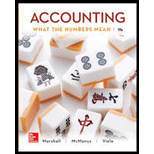
Treasury stock is the shares bought back by the company itself. A company may purchase its own shares and the shares bought back are called treasury stock. The journal entries are made at the time of sale and purchase of treasury stock as follows:
- For Purchase of treasury stock: Treasury stock account is debited and cash account is credited with the cost of treasury stock purchased.
- For Sale / Reissuance of treasury stock: Cash account is debited for the amount received on sale of treasury stock and the Treasury stock account is credited with the cost of treasury stock. For the difference in cost and sale value, Additional Paid in Capital and
Retained earnings accounts are adjusted.
Requirement-a:
To prepare:
The
Treasury stock:
Treasury stock is the shares bought back by the company itself. A company may purchase its own shares and the shares bought back are called treasury stock. The journal entries are made at the time of sale and purchase of treasury stock as follows:
- For Purchase of treasury stock: Treasury stock account is debited and cash account is credited with the cost of treasury stock purchased.
- For Sale / Reissuance of treasury stock: Cash account is debited for the amount received on sale of treasury stock and the Treasury stock account is credited with the cost of treasury stock. For the difference in cost and sale value, Additional Paid in Capital and Retained earnings accounts are adjusted.
Requirement-b:
To Calculate:
The amount of cash dividend paid in second quarter
Treasury stock:
Treasury stock is the shares bought back by the company itself. A company may purchase its own shares and the shares bought back are called treasury stock. The journal entries are made at the time of sale and purchase of treasury stock as follows:
- For Purchase of treasury stock: Treasury stock account is debited and cash account is credited with the cost of treasury stock purchased.
- For Sale / Reissuance of treasury stock: Cash account is debited for the amount received on sale of treasury stock and the Treasury stock account is credited with the cost of treasury stock. For the difference in cost and sale value, Additional Paid in Capital and Retained earnings accounts are adjusted.
Requirement-c:
To prepare:
The journal entry for the sale of treasury stock
Treasury stock:
Treasury stock is the shares bought back by the company itself. A company may purchase its own shares and the shares bought back are called treasury stock. The journal entries are made at the time of sale and purchase of treasury stock as follows:
- For Purchase of treasury stock: Treasury stock account is debited and cash account is credited with the cost of treasury stock purchased.
- For Sale / Reissuance of treasury stock: Cash account is debited for the amount received on sale of treasury stock and the Treasury stock account is credited with the cost of treasury stock. For the difference in cost and sale value, Additional Paid in Capital and Retained earnings accounts are adjusted.
Requirement-d:
To Calculate:
The amount of cash dividend paid in fourth quarter
Treasury stock:
Treasury stock is the shares bought back by the company itself. A company may purchase its own shares and the shares bought back are called treasury stock. The journal entries are made at the time of sale and purchase of treasury stock as follows:
- For Purchase of treasury stock: Treasury stock account is debited and cash account is credited with the cost of treasury stock purchased.
- For Sale / Reissuance of treasury stock: Cash account is debited for the amount received on sale of treasury stock and the Treasury stock account is credited with the cost of treasury stock. For the difference in cost and sale value, Additional Paid in Capital and Retained earnings accounts are adjusted.
Requirement-e:
To Calculate:
The number of shares of stock dividend
Want to see the full answer?
Check out a sample textbook solution
Chapter 8 Solutions
Accounting: What the Numbers Mean

 AccountingAccountingISBN:9781337272094Author:WARREN, Carl S., Reeve, James M., Duchac, Jonathan E.Publisher:Cengage Learning,
AccountingAccountingISBN:9781337272094Author:WARREN, Carl S., Reeve, James M., Duchac, Jonathan E.Publisher:Cengage Learning, Accounting Information SystemsAccountingISBN:9781337619202Author:Hall, James A.Publisher:Cengage Learning,
Accounting Information SystemsAccountingISBN:9781337619202Author:Hall, James A.Publisher:Cengage Learning, Horngren's Cost Accounting: A Managerial Emphasis...AccountingISBN:9780134475585Author:Srikant M. Datar, Madhav V. RajanPublisher:PEARSON
Horngren's Cost Accounting: A Managerial Emphasis...AccountingISBN:9780134475585Author:Srikant M. Datar, Madhav V. RajanPublisher:PEARSON Intermediate AccountingAccountingISBN:9781259722660Author:J. David Spiceland, Mark W. Nelson, Wayne M ThomasPublisher:McGraw-Hill Education
Intermediate AccountingAccountingISBN:9781259722660Author:J. David Spiceland, Mark W. Nelson, Wayne M ThomasPublisher:McGraw-Hill Education Financial and Managerial AccountingAccountingISBN:9781259726705Author:John J Wild, Ken W. Shaw, Barbara Chiappetta Fundamental Accounting PrinciplesPublisher:McGraw-Hill Education
Financial and Managerial AccountingAccountingISBN:9781259726705Author:John J Wild, Ken W. Shaw, Barbara Chiappetta Fundamental Accounting PrinciplesPublisher:McGraw-Hill Education





